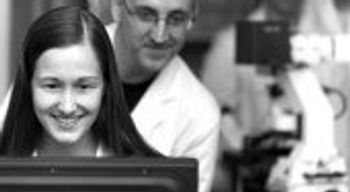
Learn about strategies for managing big image data and discover connectome research with the world’s fastest scanning electron microscope
ZEISS webinars facilitate knowledge about the newest technologies and applications in microscopy and digital imaging. With our webinars you stay ahead of the curve in research and industry, you are the first to learn about the newest technologies, and you discover how your applications benefit from ZEISS solutions.
With two upcoming webinars in November we are addressing the growing trend of generating and processing large amounts of imaging data in 2D and 3D with newest high-end microscopy systems from the meso- to the nanoscale, such as light sheet fluorescence, confocal, or scanning electron microscopy with multi-beam technology. Register today for free, take part in the discussion, and stay ahead of the curve with ZEISS!
November 18, 2015: Managing your microscopy big image data – Challenges, strategies, solutions
In this joint webinar by Science and ZEISS, the panelists Jason Swedlow and Laurent Gelman will answer the live audience’s questions and discuss:
- Image data heterogeneity and how to maintain compatibility between microscopy modalities (metadata, file formats, and open data interfaces)
- Image processing based on computer clusters and worldwide networks
- Strategies for automated data handling, processing, and storage workflows in a microscopy facility environment (for example, for automated whole slide imaging).
Acquiring images using modern techniques such as light sheet fluorescence, confocal, or electron microscopy creates a significant data stream. Add modalities like multichannel, 3-D, and time-lapse, and managing the data sets generated soon becomes a serious issue.
Researchers therefore need more efficient solutions for data storage and processing in terms of both computer hardware and software. In addition, changing workflows to incorporate these massive data requirements means substantial adaptation of training schemes and education. In this webinar, the panelists will discuss how these challenges can be addressed on both a conceptual level and in day-to-day research in the lab. They will outline systematic approaches to illustrate how microscope users can get greater benefit and more consistent results from big image data experiments, and will present examples of successful workflows.
The webinar will be of interest to scientists in any research area using microscopy or analyzing big image data to gain information from multidimensional experiments. These areas include developmental research, neurobiology and cell biology, high-content screening, medical imaging, and materials science, among others.
November 12, 2015: Enabling Connectomics with Multi-beam Scanning Electron Microscopy – The World’s Fastest SEM Just Got Even Faster
In this joint webinar by BitesizeBio and ZEISS, presented by Anna Lena Eberle, PhD, Neuroscience Specialist and Product Manager for ZEISS MultiSEM, you will learn:
- Challenges and relevance of 3D imaging for Connectomics
- 3D volume imaging with scanning electron microscopy methods
- Newest technologies for ultrastructural high-throughput imaging
Recent years have witnessed major progress in three-dimensional (3D) microscopy techniques for the life sciences as well as materials research. In particular, scanning electron microscopy (SEM) offers new insights into the 3D organization of cells and tissues by volume imaging methods, such as array tomography, serial block-face imaging or focused ion beam FIB-SEM tomography. Recently, a novel multi-beam SEM technology for imaging of large sample areas has been developed by ZEISS. The MultiSEM family features 61 or even 91 electron beams scanning in parallel, resulting in an imaging speed of up to 1820 megapixels per second. At this rate the ZEISS MultiSEM family currently provides the fastest scanning electron microscopes in the world. Complemented by the advent of automated sample preparation robots, the promise of mapping larger (1 mm³) tissue volumes at high-resolution is now within reach.
This finally strengthens a new field within the Neurosciences, namely Connectomics, where complex synaptic networks assembled by billions of neurons are studied. Structural analysis is done by first slicing neural tissue followed by imaging the sections using a scanning electron microscope. After merging all section images into a 3D volume the fine structure of neurons can be segmented and visualized. The result is a detailed 3D map of the connectivity of the brain: the Connectome.
This talk will outline some of the challenges in Connectomics and explain recent technological developments. Focus will be given to ZEISS solutions for array tomography and high-throughput electron microscopes such as the ZEISS MultiSEM.
